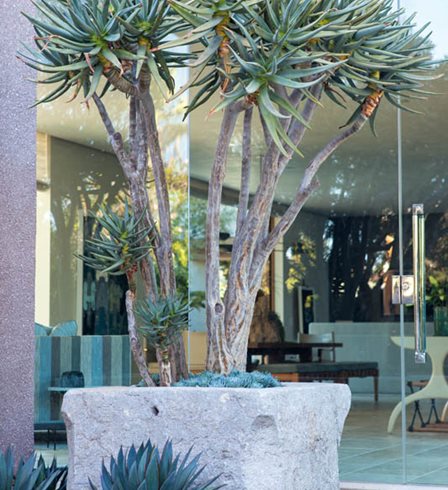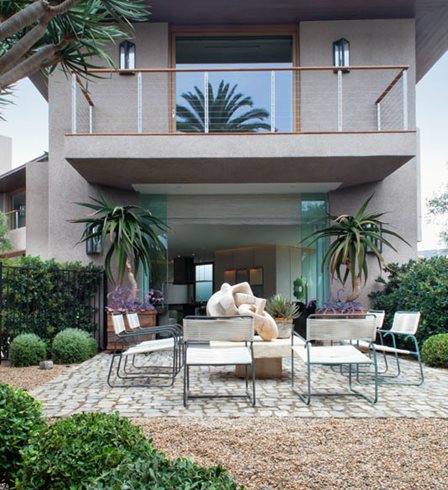Airy Outdoor Rooms Extend a Seaside Home's Living Space
The harmony between a Coronado beach house and its garden is all in the detailsLos Angeles designer Scott Shrader is known for rich but refined landscapes that mix natural materials in a range of subtle hues. At a property in Coronado, California, he combined a palette of stone, metal, and wood with olive trees and succulents to create garden spaces that flow seamlessly around a contemporary glass-and-stucco house. The house, designed by Island Architects, is a block from the beach and has floor-to-ceiling glass windows and doors that make it so transparent that “the line between indoors and out disappears,” Shrader says. As a result, the gardens had to relate completely to the interiors, and feel comfortable while standing up to the strong, modern building.
Outdoor areas were limited. The two-story, 7,000-square-foot home, finished in 2013, takes up much of its lot, with little setback from its neighbors or the street. But Shrader made the most of what he had, developing four discrete outdoor rooms that live like airy extensions of the house. The harmony between the two began, he says, with an uncommonly close design collaboration. Before the house was built, he met regularly with Island Architects, the decorators (Jeffrey Alan Marks and Ross Cassidy), and the builders (Smith Brothers Construction) to discuss and coordinate concepts, materials, and finishes. All team members weighed in on key decisions.
The owners, a couple with grown children, initially supplied some rudimentary guidelines but left much to the group. Recalls Shrader, “They knew our work and trusted us to create a casual, approachable place where they could hang out with friends and relax.”
Shrader, who has designed many seaside gardens, introduced several elements that helped tie the home to its landscape, particularly important for a see-through house that sits at garden level. The home’s external stucco finish, for example, was hand blended with bits of oyster and other shells to give it the look of “having risen from the beach.” Outdoors, Del Rio gravel paths, which connect several of the spaces, were hand-seeded, like the stucco, with beach shells. Shrader laid polished Dalle de France limestone around the salt-water pool, a choice refined enough for use as inside flooring too. Unlike many other options, says Shrader, this stone “can take constant, splashing water, especially salt water, which is more corrosive.”
In contrast to the clean, modern surface of the limestone, textured antique cobbles pave the home’s arrival court and create connecting “carpets” in other garden rooms. They mark a gathering spot around a stone table outside the living room, and further on, a lounge centered on an outdoor fireplace. “Changing surfaces underfoot signal that you’re leaving one outdoor room for another,” says Shrader, “just as they do indoors, when you go from a wood floor to a rug.”
Similarly, switching up furnishings also shifts the mood as you move among gardens. Between the house and pool, he designed a custom-concrete banquette, complete with integrated side table, for informal drinks and dining. For extra seats, he added sleek yet rustic reclaimed-wood chairs by Brazilian designer Carlos Motta. Beside the pool with its polished decking, he paired Motta’s simple wood loungers with vintage, white-glazed garden stools, a contrast of shapes and surfaces that makes each element shine. Nearby, in the small gathering spot outside the living room, he surrounded the stone table (a weighty, eighteenth-century piece) with Walter Lamb’s airy 1950s tubular bronze chairs with cord seats. “Combining vintage, modern, and antique finds in natural materials warms up a contemporary garden,” notes Shrader.
He also believes that using neutral colors keeps it quiet and serene, especially in landscapes that are organized around green. Among his first planting tasks was to hedge the front of the house from the road with a dense, enclosing waxleaf privet screen. From there, in the garden overall, different foliages, not blooms, were his focus. His short plant list includes silvery olive trees; sculptural, aqueous-toned agaves; and boxwoods sheared into globes. “This is a timeless combination that’s been used for centuries,” he explains. “It looks like it could have been done hundreds of years ago or yesterday.” The colors and textures are fully at home in California’s Mediterranean climate, particularly along the coast. Here, with the glass doors open, reflected sunlight shimmers in through the olive trees and their rustling leaves join the sound of waves on the beach.
RELATED:
Southern California Gardens
Small Gardens








